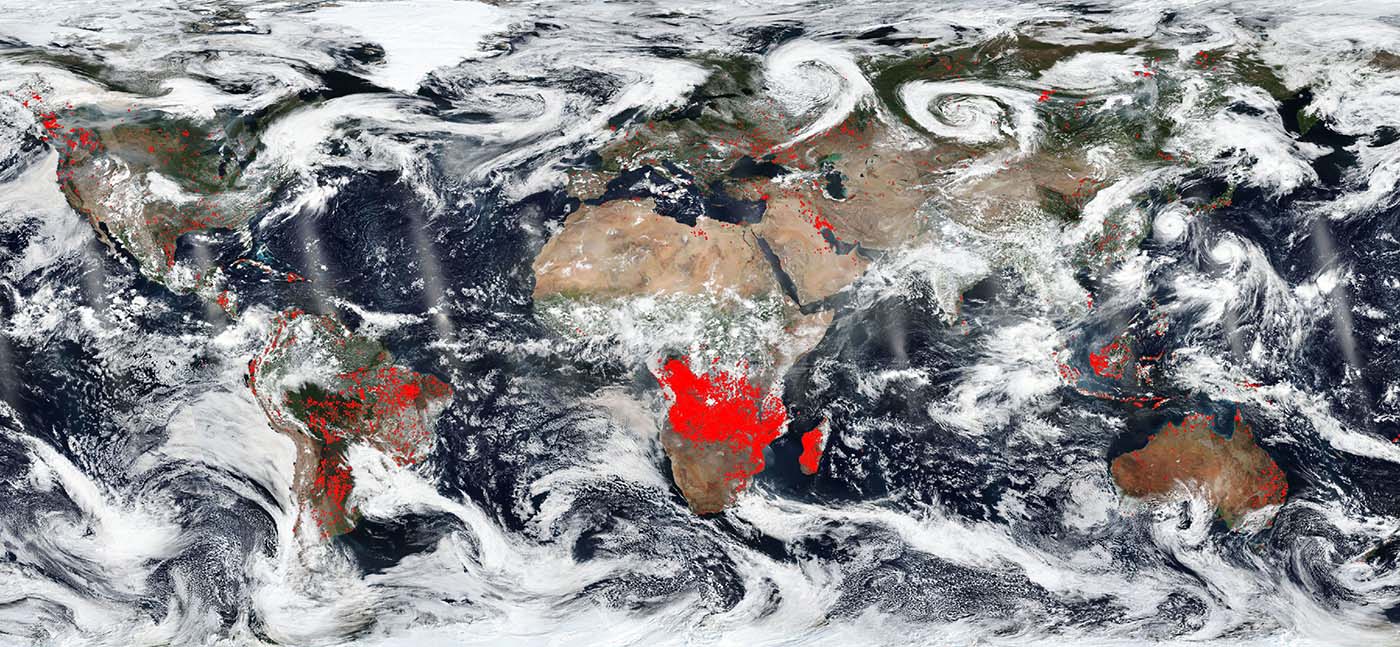Take a deep breath. Even if the air looks clear, it is nearly certain that you will inhale millions of solid particles and liquid droplets.
These ubiquitous specks of matter are known as aerosols, and they can be found in the air over oceans, deserts, mountains, forests, ice and every ecosystem in between.
If you have ever watched smoke billowing from a wildfire, ash erupting from a volcano or dust blowing in the wind, you have seen aerosols.
Satellites like NASA’s Earth-observing satellites, Terra, Aqua, Aura and Suomi NPP, “see” them as well, though they offer a completely different perspective from hundreds of kilometres above Earth’s surface. A version of a NASA model called the Goddard Earth Observing System Forward Processing (GEOS FP) offers a similarly expansive view of the mishmash of particles that dance and swirl through the atmosphere.
The visualisation pictured above highlights GEOS FP model output for aerosols on 23 August 2018 (image credit: NASA/Joshua Stevens/Adam Voiland).
On that day, huge plumes of smoke drifted over North America and Africa, three different tropical cyclones churned in the Pacific Ocean, and large clouds of dust blew over deserts in Africa and Asia. The storms are visible within giant swirls of sea salt aerosol (blue), which winds loft into the air as part of sea spray.
Black carbon particles (red) are among the particles emitted by fires; vehicle and factory emissions are another common source. Particles the model classified as dust are shown in purple.
The visualisation includes a layer of night light data collected by the day-night band of the Visible Infrared Imaging Radiometer Suite (VIIRS) on Suomi NPP that shows the locations of towns and cities.
The picture below is from NASA’s Worldview, with the red points overlaid on the image designating those areas that, by using thermal band,s detect actively burning fires.
Africa seems to have the most concentrated fires. This could be due to the fact that these are most likely agricultural fires. The location, widespread nature, and number of fires suggest that these fires were deliberately set to manage land. Farmers often use fire to return nutrients to the soil and to clear the ground of unwanted plants. While fire helps enhance crops and grasses for pasture, the fires also produce smoke that degrades air quality.
Elsewhere the fires, such as in North America, are wildfires for the most part. In South America, specifically Chile has had horrendous numbers of wildfires this year.
A study conducted by Montana State University found that: “Besides low humidity, high winds and extreme temperatures some of the same factors contributing to fires raging across the US- central Chile is experiencing a mega drought and large portions of its diverse native forests have been converted to more flammable tree plantations, the researchers said.”
However, in Brazil the fires are both wildfires and man-made fires set to clear crop fields of detritus from the last growing season. Fires are also commonly used during Brazil’s dry period to deforest land and clear it for raising cattle or other agricultural or extraction purposes.
The problem with these fires is that they grow out of control quickly due to climate issues. Hot, dry conditions coupled with wind drive fires far from their original intended burn area. According to the Global Fire Watch site, there were 30 964 fire starts between 15 August and 22 August.
Australia is also where you tend to find large bushfires in its more remote areas. Hotter, drier summers in Australia will mean longer fire seasons – and urban sprawl into bushland is putting more people at risk for when those fires break out. For large areas in the north and west, bushfire season has been brought forward a whole two months to August – well into winter, which officially began 1 June.
According to the Australian Bureau of Meteorology (Bom), the January to July period 2018 was the warmest in NSW since 1910. As the climate continues to change and areas become hotter and drier, more and more extreme bushfires will break out across the entire Australian continent.


